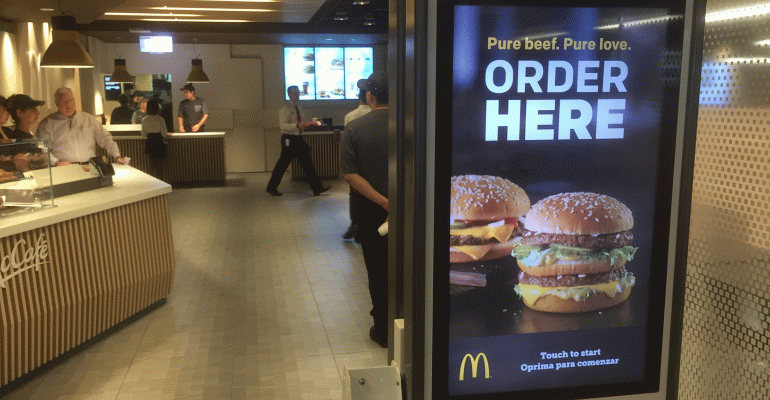 This post is part of the On the Margin blog.
This post is part of the On the Margin blog.
McDonald’s is promising kiosks in most of its 14,000 locations by 2020, through its Experience of the Future, beginning with thousands of stores across the country this year.
As is often the case, people see such kiosks and immediately see a company replacing a cashier with a robot.
Earlier this week, CNBC said that, “Wall Street cheers replacement of cashiers with kiosks.”
The blog ZeroHedge then proclaimed that, “McDonald’s is replacing 2,500 human cashiers with digital kiosks.”
Too bad it’s not true.
McDonald’s, contrary to popular belief, is not saving on labor by rolling out those kiosks. Rather than any mass layoffs of cashiers, those workers will be reassigned to other tasks in the restaurants, according to several people associated with the company. And a McDonald’s spokeswoman confirmed this to Business Insider.
Kiosks, in fact, are not a labor saver, certainly not now, and certainly not inside a fast-food chain that gets more than two-thirds of its business from the human managed drive thru.
Plenty of reasons exist for chains to use kiosks, notably in that they enable customers to more carefully consider their order. That reduces mistakes, and customers order more. They also enable companies to handle more orders during busy times, improving efficiency.
In addition, kiosks reduce problems associated with the influx of new employees into a restaurant. Few things are more annoying to a customer than giving an order to a worker just days on the job and just learning the point-of-sale system.
But rather than taking jobs, kiosks simply shift them elsewhere. McDonald’s, after all, still has to get the food ordered on the kiosks to the customers. And sometimes those workers will be called upon to help customers with the kiosks themselves.
Touch screens have been invading restaurant locations for years now, in one form or the other. Casual-dining chains have put them on tables. More quick-service chains are putting them in the lobby. Numerous concepts are also relying heavily on apps to get customers to place their order.
In short, there is a massive, industry-wide effort to adopt customer facing order technology.
There is no evidence, however, that any of these efforts are leading to overall reductions in labor. Restaurants’ labor costs increased in 2016. They continued to increase so far in 2017. And the industry has added about 273,000 employees over the past 12 months, according to federal data, a rate higher than that of the overall economy.
All that hiring is exacerbating a labor shortage that could be relieved with more automation.
Unemployment is at 4.3 percent, and the labor pool is thin, forcing restaurants to pay higher wages and lower hiring standards.
Restaurants employ a labor-heavy model, with turnover that averages much higher than 100 percent. They spend more on labor, by far, than either convenience stores or grocers, both of which have been gunning for a bigger piece of the prepared food pie.
The labor costs have put restaurants at a disadvantage over the past 18 months, as lower food costs enabled grocers to lower prices. Restaurants, because of those rising labor costs, have kept increasing prices. The result was a nearly unprecedented pricing gap of 450 basis points some months last year — and, theoretically, lower same-store sales.
Nobody likes to see layoffs. But a more efficient model that diverts more tasks to automation would be welcome at many restaurants, both by customers and the employees. It’s just not happening yet.
Jonathan Maze, Nation’s Restaurant News senior financial editor, does not directly own stock or interest in a restaurant company.
Contact Jonathan Maze at [email protected]
Follow him on Twitter: @jonathanmaze

